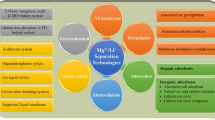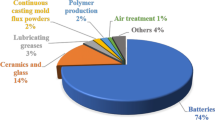Abstract
In this paper, we proposed a microextraction approach for the extraction and separation of Mn(II) and Co(II) from sulfate solution simulating leachate of spent lithium-ion battery cathode materials using saponified di-(2-ethylhexyl)phosphoric acid system. The effects of the following operational variables were investigated: equilibrium pH, tri-n-butyl phosphate concentration, saponification rate, two-phase ratio and residence time. The results showcased that the microextractor can reach the extraction equilibrium within 20 s, thereby greatly reducing necessary extraction time comparing to that of conventional processes. The volumetric mass transfer coefficient showed 8–21 times larger than that of batch device. With the help of microextractor, 95% of Mn(II) was extracted with a single theoretical stage at a chosen two-phase ratio of 3:1, and the separation factor βMn/Co was as large as 65.5. In the subsequent stripping step, more than 99% of manganese from loaded phase was easily stripped under optimal conditions. The microextraction approach greatly enhances the mass transfer while enabling a continuous and controllable extraction process within a simple structure design. When extracting spent electrode material with microextractors, the comprehensive recovery of mangenese can reach 96%. The microextraction approach has a good applicability in the spent lithium-ion battery cathode materials recycling at both bench and industrial scales.

Similar content being viewed by others
References
International Energy Agency. Global EV Outlook 2019: Scaling-up the Transition to Electric Mobility. Paris: OECD Publishing, 2019, 16–17
Harper G, Sommerville R, Kendrick E, Driscoll L, Slater P, Stolkin R, Walton A, Christensen P, Heidrich O, Lambert S, et al. Recycling lithium-ion batteries from electric vehicles. Nature, 2019, 575 (7781): 75–86
Lv W, Wang Z, Cao H, Sun Y, Zhang Y, Sun Z. A critical review and analysis on the recycling of spent lithium-ion batteries. ACS Sustainable Chemistry & Engineering, 2018, 6(2): 1504–1521
Fergus J W. Recent developments in cathode materials for lithium ion batteries. Journal of Power Sources, 2010, 195(4): 939–954
Winslow K M, Laux S J, Townsend T G. A review on the growing concern and potential management strategies of waste lithium-ion batteries. Resources, Conservation and Recycling, 2018, 129: 263–277
Jha M K, Kumari A, Jha A K, Kumar V, Hait J, Pandey B D. Recovery of lithium and cobalt from waste lithium ion batteries of mobile phone. Waste Management (New York, N.Y.), 2013, 33(9): 1890–1897
Swain B, Jeong J, Lee J, Lee G H, Sohn J S. Hydrometallurgical process for recovery of cobalt from waste cathodic active material generated during manufacturing of lithium ion batteries. Journal of Power Sources, 2007, 167(2): 536–544
Dorella G, Mansur M B. A study of the separation of cobalt from spent Li-ion battery residues. Journal of Power Sources, 2007, 170 (1): 210–215
Hossain M R, Nash S, Rose G, Alam S. Cobalt loaded D2EHPA for selective separation of manganese from cobalt electrolyte solution. Hydrometallurgy, 2011, 107(3–4): 137–140
Thakur N V. Extraction studies of base metals (Mn, Cu, Co and Ni) using the extractant 2-ethylhexyl 2-ethylhexyl phosphonic acid, PC 88A. Hydrometallurgy, 1998, 48(1): 125–131
Wang F, He F, Zhao J, Sui N, Xu L, Liu H. Extraction and separation of cobalt(II), copper(II) and manganese(II) by Cyanex272, PC-88A and their mixtures. Separation and Purification Technology, 2012, 93: 8–14
Swain B, Mishra C, Jeong J, Lee J, Hong H S, Pandey B D. Separation of Co(II) and Li(I) with Cyanex 272 using hollow fiber supported liquid membrane: a comparison with flat sheet supported liquid membrane and dispersive solvent extraction process. Chemical Engineering Journal, 2015, 271: 61–70
Joo S H, Shin S M, Shin D, Oh C, Wang J P. Extractive separation studies of manganese from spent lithium battery leachate using mixture of PC88A and Versatic 10 acid in kerosene. Hydrometallurgy, 2015, 156: 136–141
Zhao J M, Shen X Y, Deng F L, Wang F C, Wu Y, Liu H Z. Synergistic extraction and separation of valuable metals from waste cathodic material of lithium ion batteries using Cyanex272 and PC-88A. Separation and Purification Technology, 2011, 78(3): 345–351
Batchu N K, Sonu C H, Lee M S. Solvent extraction equilibrium and modeling studies of manganese from sulfate solutions by a mixture of Cyanex 301 and TBP. Hydrometallurgy, 2014, 144–145: 1–6
Cheng C Y. Purification of synthetic laterite leach solution by solvent extraction using D2EHPA. Hydrometallurgy, 2000, 56(3): 369–386
Azizitorghabeh A, Rashchi F, Babakhani A, Noori M. Synergistic extraction and separation of Fe(III) and Zn(II) using TBP and D2EHPA. Separation Science and Technology, 2017, 52(3): 476–486
Haghshenas Fatmehsari D, Darvishi D, Etemadi S, Eivazi Hollagh A R, Keshavarz Alamdari E, Salardini A A. Interaction between TBP and D2EHPA during Zn, Cd, Mn, Cu, Co and Ni solvent extraction: a thermodynamic and empirical approach. Hydrometallurgy, 2009, 98(1–2): 143–147
Ciceri D, Perera J M, Stevens G W. The use of microfluidic devices in solvent extraction. Journal of Chemical Technology and Biotechnology (Oxford, Oxfordshire), 2013, 89(6): 771–786
Xu J H, Tan J, Li S W, Luo G S. Enhancement of mass transfer performance of liquid-liquid system by droplet flow in microchannels. Chemical Engineering Journal, 2008, 141(1): 242–249
Kamio E, Seike Y, Yoshizawa H, Matsuyama H, Ono T. Microfluidic extraction of docosahexaenoic acid ethyl ester: comparison between slug flow and emulsion. Industrial & Engineering Chemistry Research, American Chemical Society, 2011, 50(11): 6915–6924
Tokeshi M, Minagawa T, Uchiyama K, Hibara A, Sato K, Hisamoto H, Kitamori T. Continuous-flow chemical processing on a microchip by combining microunit operations and a multiphase flow network. Analytical Chemistry, 2002, 74(7): 1565–1571
Darekar M, Sen N, Singh K K, Mukhopadhyay S, Shenoy K T, Ghosh S K. Liquid-liquid extraction in microchannels with Zinc-D2EHPA system. Hydrometallurgy, 2014, 144–145: 54–62
Tice J D, Lyon A D, Ismagilov R F. Effects of viscosity on droplet formation and mixing in microfluidic channels. Analytica Chimica Acta, 2004, 507(1): 73–77
Song Y, Zhao Z, He L. Lithium recovery from Li3PO4 leaching liquor: solvent extraction mechanism of saponified D2EHPA system. Separation and Purification Technology, 2020, 249: 117161
Hirayama Y, Hinoue M, Tokumoto H, Matsuoka A, Noishiki K, Muto A. Liquid-liquid extraction and separation of cobalt and lithium ions using a slug flow microreactor. Journal of Chemical Engineering of Japan, 2018, 51(3): 222–228
Muto A, Hirayama Y, Tokumoto H, Matsuoka A, Noishiki K. Liquid-liquid extraction of lithium ions using a slug flow microreactor: effect of extraction reagent and microtube material. Solvent Extraction and Ion Exchange, 2017, 35(1): 61–73
Acknowledgements
The authors gratefully acknowledge the supports of the National Natural Science Foundation of China (Grant Nos. 22025801 and 21636004) for this work.
Author information
Authors and Affiliations
Corresponding author
Rights and permissions
About this article
Cite this article
Zhou, Y., Zhuo, C., Huang, J. et al. A microextraction approach for rapid extraction and separation of Mn(II) and Co(II) using saponified D2EHPA system. Front. Chem. Sci. Eng. 16, 963–972 (2022). https://doi.org/10.1007/s11705-021-2081-7
Received:
Accepted:
Published:
Issue Date:
DOI: https://doi.org/10.1007/s11705-021-2081-7




